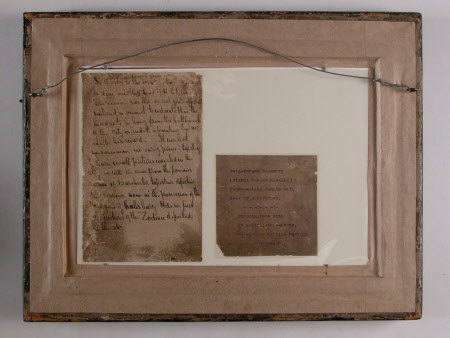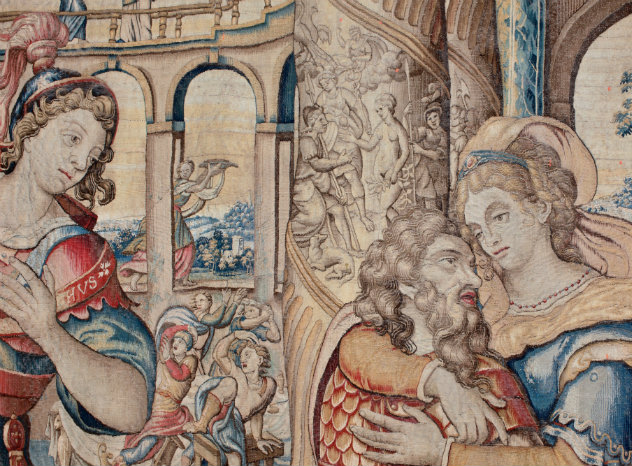Judith with the Head of Holofernes and her Maid
probably English
Category
Tapestries
Date
circa 1580 - circa 1610
Materials
Tapestry
Measurements
300 x 390 mm; 275 mm (Width); 185 mm (Height)
Place of origin
England
Order this imageCollection
Packwood House, Warwickshire
NT 557840
Caption
A small tapestry showing Judith with the head of Holofernes, finely woven with silk and gold thread. Formerly thought to have been made at the workshop established by Ralph Sheldon in Barcheston, Warwickshire, the origins of the tapestry may in fact be more mysterious.
Summary
Tapestry, wool, silk and metal thread, 8-10 warps per cm, framed, Judith with the Head of Holofernes, English, c. 1580-1610. Small tapestry panel with Judith and her maid standing in a colourful landscape. Judith holds a sword in her right hand and Holofernes’s head in her left hand, and Judith’s maid has a sack draped over her left arm which is raised. The figures stand on a grassy foreground field decorated with flowers. Immediately behind Judith on the left are two swans on a river, and on the right three tents can be seen. In the left background is the city of Bethulia, with Holofernes’s head suspended from the ramparts; trees fill the rest of the horizon. The panel has a narrow border with diagonal stripes in three colours.
Full description
The subject is taken from the Apocryphal Book of Judith, which tells the story of the Assyrian King Nebuchadnezzar’s tyranny over the lands in his dominion, and the defiance of the people of Israel. The Assyrian general Holofernes had wreaked a trail of destruction through all the coastal lands and finally laid siege to the hilltop city of Bethulia, hoping to starve the Israelites into surrender. Eventually Judith, a wealthy and god-fearing widow, resolved to act: she threw off her widow’s clothing, donned her “garments of gladness” (Judith 10.3) and set off with her maid to the Assyrian camp. Judith told the Assyrians that she had fled from the Israelites, and when she was finally allowed into the presence of the general Holofernes she recounted to him a fictitious plan to defeat them and conquer Bethulia. Holofernes marvelled at Judith’s wisdom and beauty and after she had been in the camp for a few days he finally persuaded her to dine with him: “And Holofernes took great delight in her, and drank much more wine than he had drunk at any time in one day since he was born” (Judith 12.20). When Holofernes had fallen into a drunken stupor and Judith was left alone in his tent she took the general’s double edged sword “And she smote twice upon his neck with all her might, and she took away his head from him” (Judith 13.8). Judith and her maid escaped with the general’s head hidden in a bag and returned to Bethulia, where Judith ordered that the head be displayed on the ramparts of the city. When the Assyrians discovered that their leader had been murdered their spirit failed them and they fled, and Judith was celebrated as saviour of the Israelites. The tapestry focuses on Judith herself, an instantly recognisable and iconic figure holding the head of Holofernes in one hand and the sword with which she killed him in the other. She is represented during her flight from the Assyrian camp, with subsidiary scenes in the tapestry refer to her time in the camp (the tents on the right), and her triumphant return to Bethulia to display the severed head on the ramparts of the city (in the background on the left). Although the head in this tapestry appears to be floating in mid air, other versions of the design clearly show that it would originally have been on a spike: this area of the tapestry was damaged and has been lost in restoration. Judith was an extremely popular subject in the fine and decorative arts of the sixteenth and seventeenth centuries and earlier. She was a Jewish patriotic heroine and frequently appeared as an emblem of Fortitude, or in series of illustrious women of antiquity. She was held up as an exemplar of faith in God, and of Virtue overcoming Vice; a tapestry closely related to the present example in the Metropolitan Museum is accompanied by a border with the words ‘SI DEVS NOBISCUM QVIS CONTRA NOS’ (If God is with us, who is against us) (Standen 1985, vol. 2, cat. 121, pp. 692-693). Judith is also sometimes paired with ‘Samson and Delilah’, suggesting that she could equally be an allegory of man’s misfortune at the hands of scheming women. Her story inspired many imaginative representations of her reputed beauty and finery, coupled with the gruesome results of her patriotic act; the events most frequently portrayed are the severing of Holofernes’s head, Judith putting the head into a sack held by her maid, or simply Judith holding the head as in the present instance. The tapestry design derives from at least two sixteenth-century printed sources. Judith herself is taken from an engraving by Johannes Wierix (1549-c. 1618) after Frans Floris (c. 1519-1570), published after 1570; the figure has been reversed, the costume has been simplified and the sword extended. The background elements may derive from a woodcut by Erhard Schön (c. 1491-1542) published in c. 1533. Schön’s print shows five different scenes from the siege of Bethulia, two of which have been loosely copied in the tapestry design: the group of tents on the right and the hilltop city with its spiked head displayed on the ramparts. The tapestry is one of a group of small tapestries of similar size and shape, which have traditionally been attributed to the tapestry workshop set up in the Barcheston manor house of William Sheldon in the mid sixteenth century. Our understanding of the workshop at Barcheston and its products rests largely on research published during the 1920s by John Humphreys, E A B Barnard and Professor A J B Wace (Humphreys 1920 and 1924; Barnard and Wace 1928). This research has recently been thoroughly re-evaluated by Dr Hilary Turner, who has thrown doubt upon many long-held assumptions about what constitutes a Sheldon tapestry (Turner 2008a, 2008b). Turner has argued that the basis for attributing tapestries to the Barcheston workshop, as established by Barnard and Wace in the 1920s, was based on false assumptions. She argues that although some tapestries may have been made there, others that have long been attributed to Barcheston were probably made elsewhere in England or on the continent. For instance Turner has shown that there were over 100 foreign tapestry weavers working in London in the late sixteenth century, and has suggested that much of the work formerly ascribed to the Barcheston workshop may have been produced by these weavers. The group of small tapestries to which the Packwood ‘Judith’ belongs are among the more contentious of the groups identified by Wace and his colleagues. In 1928 there were only 6 known tapestries of this type, and there are now 16 (Turner 2008a; see for example Standen 1985, cats. 121 & 123; Wingfield Digby and Hefford 1980, cats. 71b, 102d, 103c). There is arelated tapestry of the 'Adoration of the Magi' in the National Trust's collection at Fenton House (no. 1449220). They are united by their small size, fine weave, high proportion of silk thread (the Packwood example contains scarcely any wool), and the frequent lavish use of gilt metal wrapped thread (also in evidence at Packwood). Design features such as oversized foreground flowers and distinctive pipe-cleaner-shaped trees are common to many of the tapestries, as is the narrow striped ‘barber’s pole’ border seen on the ‘Judith’. The subject matter is always biblical, and both Old and New Testament subjects are found. Roughly one third of the known examples have an additional border with an inscription, sometimes in Latin and sometimes in English, of a popular saying or a biblical quotation with some relation to the figurative scene. It has been suggested by Turner that they are in fact German rather than English, based on stylistic similarity to some German sixteenth-century tapestries. However the comparison is not conclusive. The fact that the majority of these small tapestries have come to light in England, and the presence of inscriptions in English but in no other vernacular language suggest that they were made somewhere in England rather than in continental Europe. There are three further examples of tapestries of comparable size and execution to the Packwood ‘Judith’, and bearing variants of the same design. The first is in the Metropolitan Museum of Art, New York (Standen 1985, vol. II, pp. 692-693, cat. no. 121). There are some differences in the arrangement of the trees and the landscape but the overall composition is the same; the tapestry also has a decorative border inside the ‘barber’s pole’ edging, bearing the Latin inscription: ‘SI DEVS NOBISCVM / QVIS CONTRA NOS’ (If God is with us, who is against us’). The second is in the Burrell Collection in Glasgow (inv. 47.23); this tapestry has a border with the same inscription as the New York tapestry, but again there are small differences in the design, and it lacks any metal thread. The third belongs to Beolay Church and is now on long-term loan to the National Needle Museum at Redditch. It resembles the Burrell Collection version in colouring, but lacks the extra decorative border with inscription, and the design of the main panel differs from the other three in that a second city has appeared on the horizon between the two women. (Helen Wyld, 2009)
Provenance
Given to the National Trust by Graham Baron Ash in 1941
Credit line
Packwood House, The Graham Baron Ash Collection (The National Trust)
Makers and roles
probably English, workshop previously catalogued as workshop of Ralph Sheldon (1537-1613), workshop
References
Packwood House 1931-38: Graham Baron Ash's Scrapbook c. 1931-1938 (557381) , Photograph with handwritten note: "Sheldon Tapestry Cushion woven at Barcheston Warwickshire 1610. Sir W. Burrell & the Duke of Rutland have similar ones. Bought from Malet. Exhibited Stoneythorpe 1938." Turner 2008, Hilary L Turner, 'Tapestries once at Chastleton House and Their Influence on the Image of the Tapestries Called Sheldon: A Reassessment', The Antiquaries Journal, vol. 88 (September 2008), pp. 313-346 Turner 2008, Hilary L Turner, ‘Tapestry sections depicting the Prodigal Son: how safe is an attribution to Mr Sheldon’s tapestry venture at Barcheston?’, Archaeologica Aeliana, vol. 37 (2008), pp. 183-196 Standen, 1985: Edith Appleton Standen, European post-medieval tapestries and related hangings in the Metropolitan Museum of Art, New York 1985 Wingfield Digby and Hefford, 1980: George Wingfield Digby and Wendy Hefford, Victoria and Albert Museum: The Tapestry Collection, Medieval and Renaissance, London 1980 Barnard and Wace, 1928: E. A. B. Barnard and A. J. B. Wace, 'The Sheldon Tapestry Weavers and their Work', Archaeologia, lxxviii (1928), pp. 255-318


